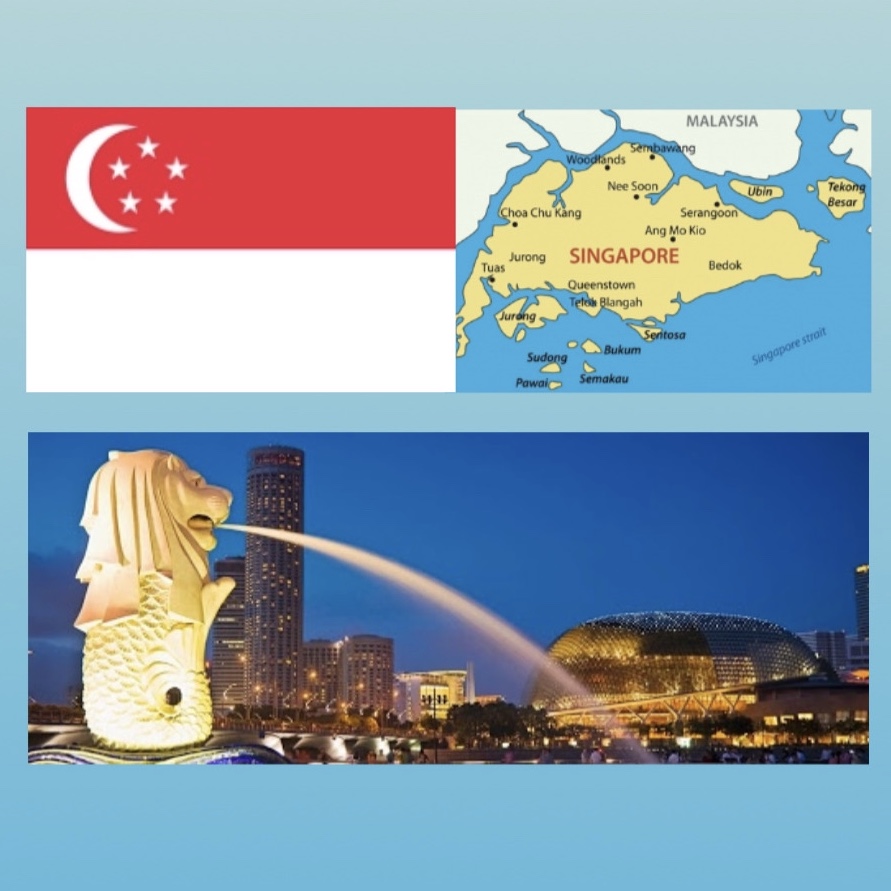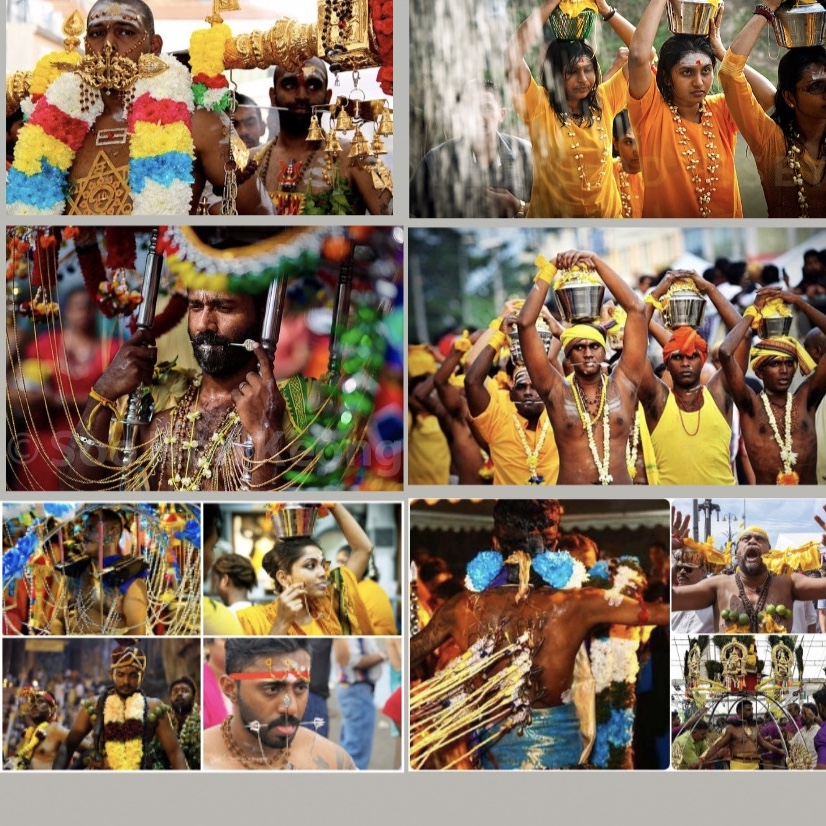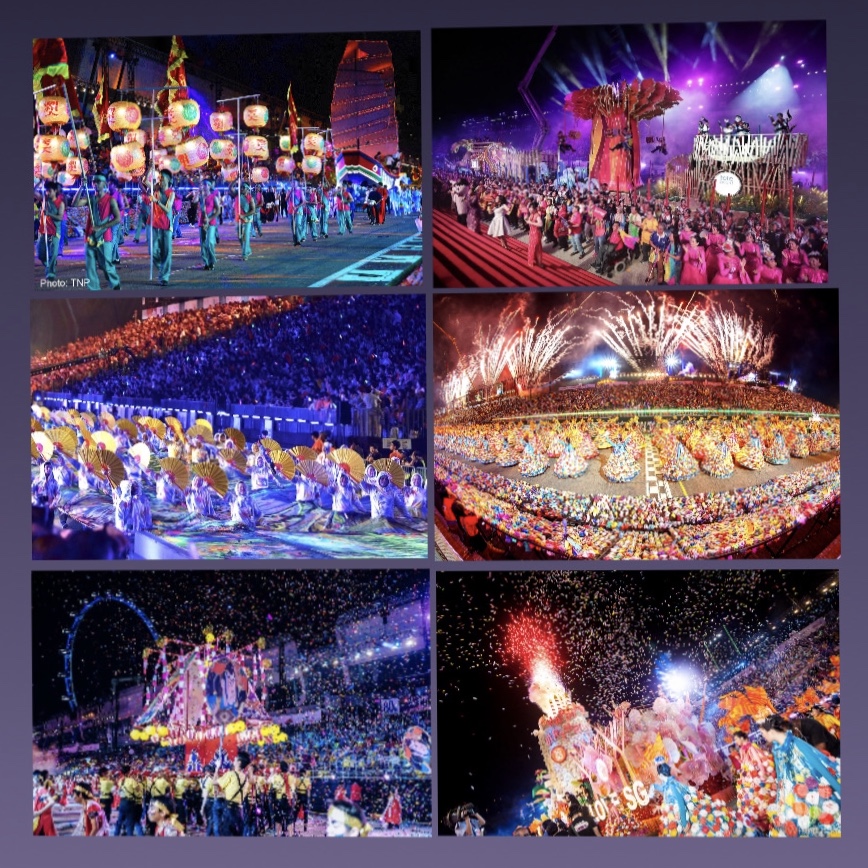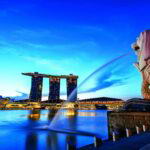Đảo quốc sư tử này vẫn luôn khiến mọi người đứng ngồi không yên vì những công trình kiến trúc đẹp, có nhiều khu vui chơi giải trí hàng đầu châu Á . Và là thiên đường mua sắm với những trung tâm thương mại sầm uất.Và còn những điều cần biết về Singapore mà bạn chưa khám phá hết thì hãy cùng A+ English đọc bài viết dưới đây nhé!
Nội dung chính
1. Vị trí địa lí
Singapore, tên chính thức là nước Cộng hòa Singapore, là một thành bang và đảo quốc tại Đông Nam Á. Đảo quốc nằm ngoài khơi mũi phía nam của bán đảo Mã Lai và cách xích đạo 137 km về phía bắc. Singapore là một hòn đảo có hình dạng một viên kim cương được nhiều đảo nhỏ khác bao quanh.

Có hai con đường nối giữa Singapore và bang Johor của Malaysia . Một con đường nhân tạo có tên Đường đắp cao Johor-Singapore ở phía bắc, băng qua eo biển Tebrau và liên kết thứ hai Tuas, một cầu phía tây nối với Johor.
Nó có tổng cộng 63 hòn đảo lớn nhỏ. Trong đó, Đảo Jurong, Pulau Tekong, Pulau Ubin và Sentosa là những đảo lớn nhất của Singapore. Ngoài ra còn có nhiều đảo nhỏ khác. Vị trí cao nhất của Singapore là đồi Bukit Timah với độ cao 166m
Tổng diện tích của Singapore là 712 km2, phần đất liền chiếm khoảng 682,7 km2.
Thủ đô: Singapore
2. Dân số
Hiện tại dân số là 5.892.556 người vào ngày 29/05/2021 theo số liệu mới nhất từ Liên Hợp Quốc. Hiện chiếm 0,07% dân số thế giới. Đang đứng thứ 114 trên thế giới trong bảng xếp hạng dân số các nước và vùng lãnh thổ. Mật độ dân số là 8.418 người/km2. 100,00% dân số sống ở thành thị (5.850.343 người vào năm 2019). Độ tuổi trung bình là 42,7 tuổi.
3. Kinh tế
Singapore có cơ sở hạ tầng và một số ngành công nghiệp phát triển cao hàng đầu châu Á và thế giới. Như: cảng biển, công nghiệp đóng và sửa chữa tàu, công nghiệp lọc dầu, chế biến và lắp ráp máy móc tinh vi.
Hầu như không có nguồn tài nguyên thiên nhiên. Các nguyên liệu phần lớn nhập từ nước ngoài.
Singapore có 12 khu vực công nghiệp lớn, trong đó lớn nhất là Khu công nghiệp Jurong. Là nước hàng đầu về sản xuất ổ đĩa máy tính điện tử và hàng bán dẫn. Đây còn là trung tâm lọc dầu và vận chuyển quá cảnh hàng đầu ở châu Á. Singapore cũng được coi là nước đi đầu trong việc chuyển đổi sang nền kinh tế tri thức.
Thứ hạng của Singapore
Có hơn 7.000 tập đoàn đa quốc gia đến từ Hoa Kỳ, Nhật Bản và Châu Âu tại Singapore. Đất nước này là nhà đầu tư nước ngoài lớn thứ hai ở Ấn Độ. Đây là nhà xuất khẩu lớn thứ 14 và là nhà nhập khẩu lớn thứ 15 trên thế giới
Năm 2016, Singapore được Đơn vị Tình báo Kinh tế đánh giá là thành phố đắt đỏ nhất thế giới trong năm thứ ba liên tiếp. Và điều này vẫn đúng trong năm 2018. Tính đến năm 2018, thứ hạng của Singapore trong Chỉ số phát triển con người đứng thứ 9 trên thế giới, với giá trị HDI là 0,935.
Đất nước này cũng được coi là nước đi đầu trong việc chuyển đổi sang nền kinh tế tri thức. Nó đang thực hiện kế hoạch đến năm 2018 sẽ biến nơi đây thành một thành phố hàng đầu thế giới. Một đầu mối của mạng lưới mới trong nền kinh tế toàn cầu và châu Á . Và một nền kinh tế đa dạng nhạy cảm kinh doanh.
4. Khí hậu
Khí hậu ở đây tương đối giống với khí hậu Việt Nam .lLà khí hậu nhiệt đới và nắng quanh năm. Với sự tác động của vùng duyên hải nên nhiệt độ hầu như duy trì ở mức độ từ 24 độ C và 32 độ C. Có độ ẩm rất cao, khoảng 84,4%. Tháng 12 là tháng mưa liên tục, tháng 02 là tháng nắng suốt cả tháng. Với tháng 07 và tháng 08 là tháng nóng nhất với nhiệt độ cao đạt mức tối đa.
5. Ngôn ngữ
Singapore được coi là một quốc gia của người nhập cư với nhiều thành phần dân tộc đa dạng. Song các dân tộc gốc châu Á chiếm ưu thế với 75% dân số là người gốc Hoa. Các cộng đồng thiểu số đáng kể là người Mã Lai, người Ấn Độ, người Âu-Mỹ và người lai Âu-Á.
Quốc gia này có bốn ngôn ngữ chính thức là tiếng Anh, tiếng Mã Lai, tiếng Hoa và tiếng Tamil. Chính phủ nước này thúc đẩy chủ nghĩa văn hóa đa nguyên thông qua một loạt các chính sách chính thức.
6. Lịch sử
Từ thế kỷ 16 đến thế kỷ 19 cùng với sự bành trướng của thế lực thực dân đang chia nhau những miếng bánh Châu Á, Malaysia lúc bấy giờ đang nằm trong quyền kiểm soát của người Hà Lan. Lúc này Anh chính thức hất cẳng Hà Lan ra khỏi khu vực này và chia cắt SIngapore khỏi Malaysia đánh dấu việc hình thành đất nước Singapore như ngày nay.
Chiến tranh thế giới thứ 2 nổ ra, là một trong những căn cứ lớn của quân đội Đồng Minh không có gì lạ khi Singapore bị phát xít Nhật nhắm tới. Ngày 15 tháng 2 năm 1942 quân Đồng Minh đầu hàng, Singapore rơi vào tay người Nhật. Họ đã áp đặt rất nhiều những biện pháp hà khắc lên người dân nơi đây khiến cho hàng nghìn người đã phải thiệt mạng
Ngày 15 tháng 2 năm 1942 quân Đồng Minh đầu hàng, Singapore rơi vào tay người Nhật. Họ đã áp đặt rất nhiều những biện pháp hà khắc lên người dân nơi đây khiến cho hàng nghìn người đã phải thiệt mạng
Tuy nhiên chỉ 3 năm sau đó vào năm 1945, phát xít sụp đổ Anh quốc lại một lần nữa trở lại quyền cai trị với bán đảo Singapore. Tuy nhiên do sự thất bại và đầu hàng của quân đội Anh trước đây họ đã không con có được sự tín nhiệm của người dân đảo quốc sư tử nữa.
Đạo luật quốc gia Singapore
Các nhà cầm quyền Singapore đương thời đã nhiều lần yêu cầu Anh quốc trả lại quyền tự trị cho mình. Nhưng đều bị từ chối mãi cho đến năm 1958, đạo luật quốc gia Singapore đã được Nghị viện Anh Quốc thông qua. Và quốc gia Singapore được hình thành.
Năm 1963, Singapore sáp nhập với Malaysia nhằm củng cố hơn các mối quan hệ cũng như nâng cao vị thế của quốc gia. Do sự bất đồng về chính sách và những sự xung đột nên sự hợp nhất không đạt được nhiều thành công. Dẫn đến chủ 2 năm sau Singapore tách khỏi Malaysia và trở thành một quốc gia độc lập. Và có nền dân chủ và chủ quyền lãnh thổ hoàn toàn riêng biệt như ngày nay.
Ngay sau khi tách ra khỏi Malaysia thủ tướng Lý Quang Diệu đã cho thực hiện những chính sách vô cùng sáng suốt. Nhằm thu hút nhân tài và củng cố đất nước khiến cho chỉ trong vòng 10 năm .Đã khiến cho Singapore nghèo nàn sau chiến tranh thế giới thứ 2 trở lại thành một trung tâm kinh tế phát triển bậc nhất của châu Á.
7. Văn hoá
Singapore là một quốc gia đa chủng tộc với nhiều lễ hội và tết của nhiều quốc gia. Như Mã lai, Ấn Độ, Trung Quốc, các nước phương Tây…
Lễ hội màu sắc của Singapore – Thaipusam.: Được tổ chức thường niên nhằm tỏ lòng tôn kính với vị thần của người Hindu Subramaniam (chúa tể Murugan).

Lễ hội Chingay: là lễ hội đường phố Chingay được tổ chức hàng năm trong dịp Tết âm lịch. Đây là một dịp để người dân Singapore thể hiện và củng cố nền văn hoá đa sắc tộc của mình.

Văn hóa đặc trưng về ẩm thực:
Là đất nước đa dạng về dân tộc, vì thế nền ẩm thực cũng bị ảnh hưởng rất nhiều. Các món ăn là sự pha trộn giữa nhiều vùng miền, đặc biệt là Trung Hoa, Ấn Độ và Peranalean,… Một số món ăn ngon ở đây phải kể tới như: cua sốt ớt, cà ri laska, roti prata, Char Kway Teow,…
Người dân quốc đảo sư tử này thường kiêng những con số như: 4, 7, 13 và 69. Trong đó đặc biệt là số 7 – Con số mang lại điều xui xẻo, không may mắn. Vì thế trong công việc họ thường tránh con số này.
Người dân nơi đây thường kỵ màu đen – .Bởi đây là màu không may mắn và màu tím cũng gần giống với màu đen. Vì thế người ta cũng không thích. Còn màu hồng, đỏ, xanh là màu họ thường dùng nhiều nhất.
Trong văn hóa tặng quà, bạn nên lưu ý những món đồ cần phải tránh đó là không nên tặng đồng hồ .Bởi nó thể hiện điềm tang tóc. Không nên tặng khăn tay, bởi thể hiện sự chia ly. Không nên tặng ô, dù, bởi nó thể hiện sự rủi ro, không may mắn.
8. Những nơi nổi tiếng ở Singapore

Công viên Merlion.
Marina Bay Sands.
Garden by the Bay.
Cầu Helix.
China Town.
Little India.
Clark Quay.
Orchard Road.
9. Những thành tựu đạt được
Phát minh thành công “điều hòa xanh” làm lạnh bằng nước
Các nhà nghiên cứu tại Singapore đã phát minh ra loại quần áo “thông minh” có thể kích tín hiệu, đồng thời tiết kiệm pin cho các thiết bị không dây như tai nghe và đồng hồ thông minh
Phát minh cửa sổ chống ồn
Phát triển kinh tế vượt bậc và trở thành con rồng xanh của Châu Á.
10. Những trường đại học danh tiếng ở Singapore
National University of Singapore (NUS)
Nanyang Technological University.
Singapore Management University (SMU)
The Singapore University of Technology and Design (SUTD)
The Singapore Institute of Technology (SIT)
SINGAPORE
Geography
Singapore, officially the Republic of Singapore, is a Southeast Asian city-state and island nation. The island nation is located 137 kilometers north of the equator, off the southern tip of the Malay peninsula.
Country is a diamond-shaped island surrounded by many smaller islands.
Singapore and the Malaysian state of Johor are linked by two roads: the Johor-Singapore Causeway to the north, which crosses the Tebrau Strait, and the second Tuas link, a western bridge to Johor.
It has a total of 63 islands, both large and small. Jurong Island, Pulau Tekong, Pulau Ubin, and Sentosa are Singapore’s largest islands, with many smaller islands in between. Bukit Timah Hill, at an elevation of 166 meters, is Singapore’s highest point.
Singapore has a total area of 712 square kilometers, with the mainland occupying approximately 682.7 square kilometers.
Capital: Singapore
Population
According to the most recent United Nations figures, Singapore’s current population is 5,892,556 as of May 29, 2021.
Population of Singapore has a population of 0.07 percent of the world’s population. Singapore is ranked 114th in the world by population of countries and territories. Singapore has a population density of 8,418 people per square kilometer. Urban areas are home to 100 percent of the population (5,850,343 people in 2019). Singapore’s median age is 42.7 years old.
Economy
Singapore has developed infrastructure and some of the most advanced industries in Asia and the world, including seaports, shipbuilding and repair, oil refining, and the processing and assembly of sophisticated machinery.
Singapore is almost devoid of natural resources. The majority of the raw materials are imported from other countries.
Jurong Industrial Park is the largest of Singapore’s 12 major industrial zones. Singapore is a world leader in the manufacture of electronic computer drives and semiconductors. Singapore is also a major Asian oil refining and transit hub. It is also regarded as a forerunner in the shift to a knowledge-based economy.
Singapore’s rank
This is home to over 7,000 multinational corporations from the United States, Japan, and Europe. Singapore is India’s second largest foreign investor. It is the world’s 14th largest exporter and 15th largest importer.
The Economist Intelligence Unit named Singapore the most expensive city in the world for the third year in a row in 2016, and this remains true in 2018.
Singapore is ranked 9th in the world in the Human Development Index as of 2018, with an HDI value of 0.935.
It is also regarded as a forerunner in the shift to a knowledge-based economy. It is working on a plan that will transform the city-state into a leading global city, a hub for new networks in the global and Asian economies, and a diverse, business-sensitive economy by 2018.
This country is a city-state in the Southeast It is also regarded as a forerunner in the transition to a knowledge economy. Singapore is working on a plan that will transform the city-state into a leading global city, a hub for new networks in the global and Asian economies, and a business-sensitive, diverse economy by 2018.
Climate
Singapore’s climate is similar to that of Vietnam, which is tropical and sunny all year. The temperature in Singapore is almost always between 24oC and 32oC due to the influence of the coastal area. Singapore has a very high humidity level of 84.4 percent. December is a month of constant rain, whereas February is a month of constant sunshine.
Language
Singapore is considered an immigrant country with a diverse ethnic background. However, ethnic groups of Asian descent predominate, with Chinese constituting 75% of the population and Malay, Indian, U-American, and Eurasian constituting significant minorities.
Singapore’s government promotes cultural pluralism through a series of official policies in English, Malay, Chinese, and Tamil, the country’s four official languages.
It is considered an immigrant country with a diverse ethnic background.Ethnic groups of Asian descent predominate, with Chinese constituting 75 percent of the population and Malay, Indian, U-American, and Eurasian constituting significant minorities.
Singapore’s government promotes cultural pluralism through a series of official policies in English, Malay, Chinese, and Tamil, the country’s four official languages.
History
Malaysia was under Dutch control from the 16th to the 19th centuries, along with the expansion of colonial power sharing the Asian pie. At the time, Britain officially kicked the Dutch out of the area and separated Singapore from Malaysia, resulting in the formation of Singapore as it is today.
When World War II broke out, Singapore, as one of the major Allied army bases, was frequently targeted by Japanese fascists. The Allies surrendered on February 15, 1942, and Singapore fell to the Japanese. They have imposed a slew of harsh measures on the people here, resulting in the deaths of thousands.
The Allies surrendered on February 15, 1942, and Singapore fell to the Japanese. They have imposed a slew of harsh measures on the people here, resulting in the deaths of thousands.
However, only three years later, in 1945, after the fascist regime had collapsed, Britain reclaimed control of the Singapore peninsula.
However, because of the British army’s previous defeat and surrender, they did not gain the trust of the people of the Lion Island nation.
Singapore National Act
The current Singaporean rulers repeatedly requested that Britain return its autonomy, but were refused until 1958, when the Singapore National Act was passed by the British Parliament and the Singapore Nationality was approved.
Singapore merged with Malaysia in 1963 to strengthen relations and elevate the nation’s status. The merger was not very successful due to policy disagreements and conflicts, resulting in Singapore’s owner separating from Malaysia and becoming an independent country with complete democracy and territorial sovereignty two years later. As it stands today, it is completely separate.
Immediately after Singapore’s independence from Malaysia, Prime Minister Lee Kuan Yew implemented extremely wise policies to attract talent and strengthen the country, leaving Singapore impoverished ten years later. The second world has developed into one of Asia’s most developed economic centers.
Culture
Singapore is a multi-racial country with many festivals and festivals from other countries, including Malaysia, India, China, Western countries, and so on. Thaipusam, Singapore’s Color Festival, is held every year to honor the Hindu gods Subramaniam (God Murugan).
Chingay Festival: During the Lunar New Year, Singapore hosts the Chingay Parade or Chingay Street Festival. Singaporeans can use this opportunity to express and strengthen their multi-ethnic culture.
Singapore’s distinct culinary culture:
As a country with a diverse ethnic population, the cuisine is heavily influenced. The cuisine is a mash-up of many different regions, particularly China, India, and Peranalean,… Some delectable Singaporean dishes must be mentioned: chili crab, curry laksa, roti prata, Char Kway Teow, and so on.
The people of this lion island nation frequently avoid numbers such as: 4, 7, 13, and 69, particularly the number 7 – The number brings bad luck, bad luck, so they often avoid it at work.
People here dislike black because it is considered unlucky, and because purple is similar to black, they dislike it as well. And the colors they use the most are pink, red, and blue.
In the gift-giving culture, the following items should be avoided: Watches should not be given as a gift because they represent bereavement. Handkerchiefs should not be given because they indicate separation. Do not give umbrellas because they represent risk and bad luck.
Some of famous place in Singapore
Merlion park
Marina Bay Sands.
Garden by the Bay.
Cầu Helix.
China Town.
Little India.
Clark Quay.
Orchard Road.
Outstanding achievement
Singapore has successfully developed a “green air conditioner” that is cooled by water.
Singaporean researchers have developed “smart” clothing that can boost signals and save battery power for wireless devices such as headphones and smartwatches.
Making noise-cancelling windows
Outstanding economic development and transformation into Asia’s green dragon.
Singapore’s Reputable Universities
National University of Singapore (NUS)
Nanyang Technological University.
Singapore Management University (SMU)
The Singapore University of Technology and Design (SUTD)
The Singapore Institute of Technology (SIT)
Qua những điều cần biết về Singapore, A+ English mong có thể giúp các bạn bổ sung thêm nhiều kiến thức bổ ích về quốc gia này






